

'Drawdown' and global warming's hopeful new math. This week marks the publication of an ambitious new book with the audacious goal of showing how to reverse the warming of the planet through a myriad of innovations, many of them led by business for profit.

"Drawdown: The Most Comprehensive Plan Ever Proposed to Reverse Global Warming" (Penguin Books), was edited by the author and entrepreneur Paul Hawken along with a self-described "coalition" of research fellows, writers and advisors. (Full disclosure: I played a very small unpaid role in reviewing parts of the manuscript, and am included among the 120 or so advisors listed in the book.) The book contains 80 solutions — "techniques and practices" — that are ready today, and 20 additional "coming attractions" — innovations just over the horizon — that collectively can draw down atmospheric concentrations of greenhouse gases in order to solve, not just slow, climate change by avoiding emissions or sequestering carbon dioxide already in the atmosphere.
Cold calculations. The Air We Breathe: connecting through air quality monitoring. Air quality is an inherently important aspect of both personal and environmental health.
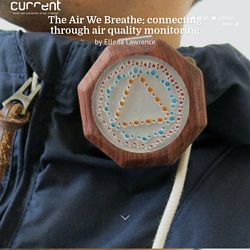
This is a problem that many Canadians struggle with due industries’ proximity to residential areas. This project focuses on two communities in Ontario, Aamjiwnaang and Sarnia, which are next door neighbours to Chemical Valley, Canada’s largest refinery of petrochemical products. Health effects on the community have been dire; girls are born at double the rate of boys, there is a high rate of asbestos related diseases, and about 40% of community members require an inhaler [1].
Introducing … The Nearly Carbon-Free Academic Conference: The World in 2050 - Resilience. Introducing … The Nearly Carbon-Free Academic Conference: The World in 2050 - Resilience. Everything Is Connected. Jane Poynter: What Lessons Came Out Of Biosphere 2? Part 2 of the TED Radio Hour episode "Everything Is Connected.
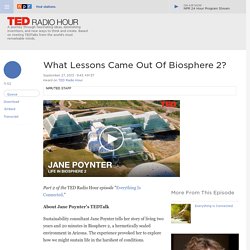
" About Jane Poynter's TEDTalk Jane Poynter lived in Biosphere 2 for two years and 20 minutes. Why Architects Must Rethink Carbon (It's Not the Enemy We Face) - Point of View - January 2017. Susan Szenasy William McDonough, 2016.
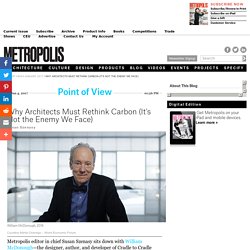
Theconversation. Whether you’re a boatie or not, everyone realises the importance of keeping the water on the outside when you go sailing or fishing.
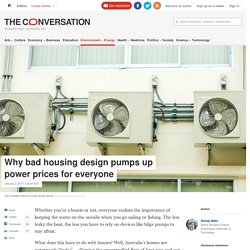
The less leaky the boat, the less you have to rely on devices like bilge pumps to stay afloat. What does this have to do with houses? Well, Australia’s homes are notoriously “leaky” – allowing the uncontrolled flow of heat into and out of the building. Our answer has been to put in more and more pumps, in the form of air conditioning. This is often promoted as a feature, rather than an indication of a poor-quality building! This creates problems for everyone. We all know that some houses are hotter than others in heatwaves, and that well insulated and designed homes cost a lot less to operate throughout the year because they don’t rely heavily on air conditioners or heaters to provide comfort. But did you know that relying on air conditioners to stay cool on hot summer days affects the price of electricity for everyone, all year round?
Institute of Professional Editors Ltd. By Kathie Stove DE The Chicago manual of style (1993) identifies why editors use style sheets: No style book will provide rules covering all matters of style encountered by the editor, and no editor worth the title will apply identical rules to every book manuscript.
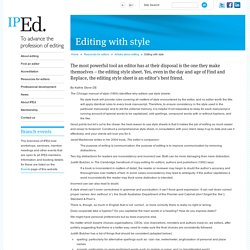
Greenbiz. How An Offers & Needs Market Helps Build Sustainable Practice. The irony of the modern market is that it can get a spare part from across the world, but a neighbour still might not know that the mechanic with the skills to fix the car is right next door – Donnie Maclurcan So often, people working on sustainability in different organisations or communities are facing the same challenges.
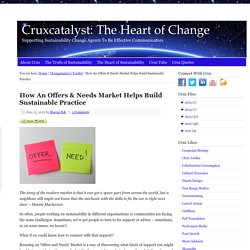
Sometimes, we’ve got people to turn to for support or advice – sometimes, or on some issues, we haven’t. What if we could know how to connect with that support? Running an ‘Offers and Needs’ Market is a way of discovering what kinds of support you might be able to provide to others, and what kinds you might need. And even though it doesn’t sound green (or perhaps because it doesn’t sound green!) What is an Offers & Needs Market? Bill Mollison Permaculture Lecture Series On-Line. Straw Bale Construction Straw bale construction is gaining worldwide recognition as a viable, high-performance, earth- and people-friendly building technique which utilizes a natural by-product of food production.
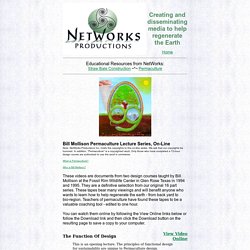
How to Cultivate Conditions for Institutional Change. "Living Systems and Leadership: Cultivating Conditions for Institutional Change," by Center senior editor Michael K.
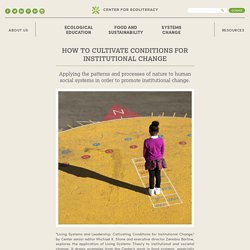
Stone and executive director Zenobia Barlow, explores the application of Living Systems Theory to institutional and societal change. It draws examples from the Center's work in food systems, especially our work on multiple levels of scale in the Oakland (California) Unified School District. The article appeared originally in a slightly different form as a scholarly feature in the Journal of Sustainability Education's March, 2011 edition, whose theme is "Learning and Leading Sustainability.
" Download the article (737k pdf) The Journal of Sustainability Education is a peer-reviewed forum to share, critique, and promote research, practices, and initiatives around sustainability. Leverage Points: Places to Intervene in a System - The Solutions Journal. In Brief Editor’s note: Donella Meadows’ Leverage Points is a classic reference for those seeking to implement change. As she tells it, Meadows was at a conference on global trade when it occurred to her that the participants were going about everything the wrong way.
“These nice, liberal folks” were trying to control growth with adjustments that were “way too puny!” Systems Thinking. One lesson that nature teaches is that everything in the world is connected to other things.

John Muir famously wrote, "When we try to pick out anything by itself, we find it hitched to everything else in the universe. " A system is a set of interrelated elements that make a unified whole. Individual things—like plants, people, schools, watersheds, or economies—are themselves systems and at the same time cannot be fully understood apart from the larger systems in which they exist. Systems thinking is an essential part of schooling for sustainability. A systems approach helps young people understand the complexity of the world around them and encourages them to think in terms of relationships, connectedness, and context. Thinking systemically requires several shifts in perception, which lead in turn to different ways to teach, and to different ways to organize institutions and society. From parts to the whole. Suzanne Simard: How trees talk to each other. Clouds In Each Paper, by Thich Nhat Hanh. --by Thich Nhat Hanh (Mar 25, 2002) If you are a poet, you will see clearly that there is a cloud floating in this sheet of paper.
Without a cloud, there will be no rain; without rain, the trees cannot grow: and without trees, we cannot make paper. The cloud is essential for the paper to exist. There is no "Away" Suzanne Simard: How trees talk to each other. Johan Rockstrom: Let the environment guide our development. The climate crisis is already here – but no one’s telling us. Book « Walk Out Walk On. In this era of increasingly complex problems and shrinking resources, can we find meaningful and enduring solutions to the challenges we face today as individuals, communities and nations? In Walk Out Walk On: A Learning Journey into Communities Daring to Live the Future Now, Margaret Wheatley and Deborah Frieze invite you on a learning journey to seven communities around the world to meet people who have walked out of limiting beliefs and assumptions and walked on to create healthy and resilient communities.
These Walk Outs who Walk On use their ingenuity and caring to figure out how to work with what they have to create what they need. – By the bestselling author of Leadership and the New Science and Turning to One Another – Provides an intimate experience of how seven different communities took on intractable problems by working together in new and different ways. Resources for Primary Schools - Shine Lab. Jeremy Corbyn: the green Britain I want to build. Jeremy Corbyn's landslide victory for leadership of the British Labour Party will change the landscape of world politics. His stands are far to the left of the Labour Party of the last 20 years, in the same way that Bernie Sanders is to the left of the Democratic Party leadership in the U.S. ProtectingOurPlanet JeremyCorbyn. Systems thinking. The Designer's Challenge: Four Problems You Must Solve.
Take the Money and Burn: How CEO Pay Accelerates Climate Change. Runaway CEO pay at the 30 largest U.S. public fossil fuel corporations rewards short-term actions, with disastrous results for the world’s climate, a new report finds. CEOs at big oil, gas and coal corporations are rewarded for a short-term fixation on pumping up quarterly share prices. They receive pay perks for expanding carbon reserves and building unnecessary fossil fuel infrastructure. Pioneering Modern Natural Dyes. Ecomodernism: a Response to my Critics. Theconversation. When the sun shines at its brightest, many of Australia’s 1.3 million homes with rooftop photovoltaic (PV) solar panels generate more electricity than they use.
Theconversation. What does your vision of a sustainable future look like? Why Walkability Matters. Crossing the street image via shutterstock. Everything Gardens: Growing Transition Culture. Sustainability: The Five Core Principles. Dr. Michael Ben-Eli is an international consultant on management and organization. Five Core Principles of Sustainability. The Four System Conditions of a Sustainable Society. Learningandskills. Sustainable-future.pdf. James Hansen Spells Out Climate Danger Of The 'Hyper-Anthropocene' Age. Visions of Resilience Workshop Tools - Victorian Ecoinnovation Lab (VEIL) Visions of Resilience - final report released - Victorian Ecoinnovation Lab (VEIL) Moral Discomfort, Privilege, and the Politics of Air-Conditioning.
It's the Second Dirtiest Thing in the World—And You’re Wearing It. The World If: A compilation of scenarios. The Earth's Battery Is Running Low. Why Sustainability Is Now the Key Driver of Innovation. Dichotomistic - about the author John McCrone.
Can accounting save the planet? Stone.Trees_Standing. Garnaut_Chapter6.pdf. Food security. Service Design & UX Agency, Melbourne, Australia. Food production.